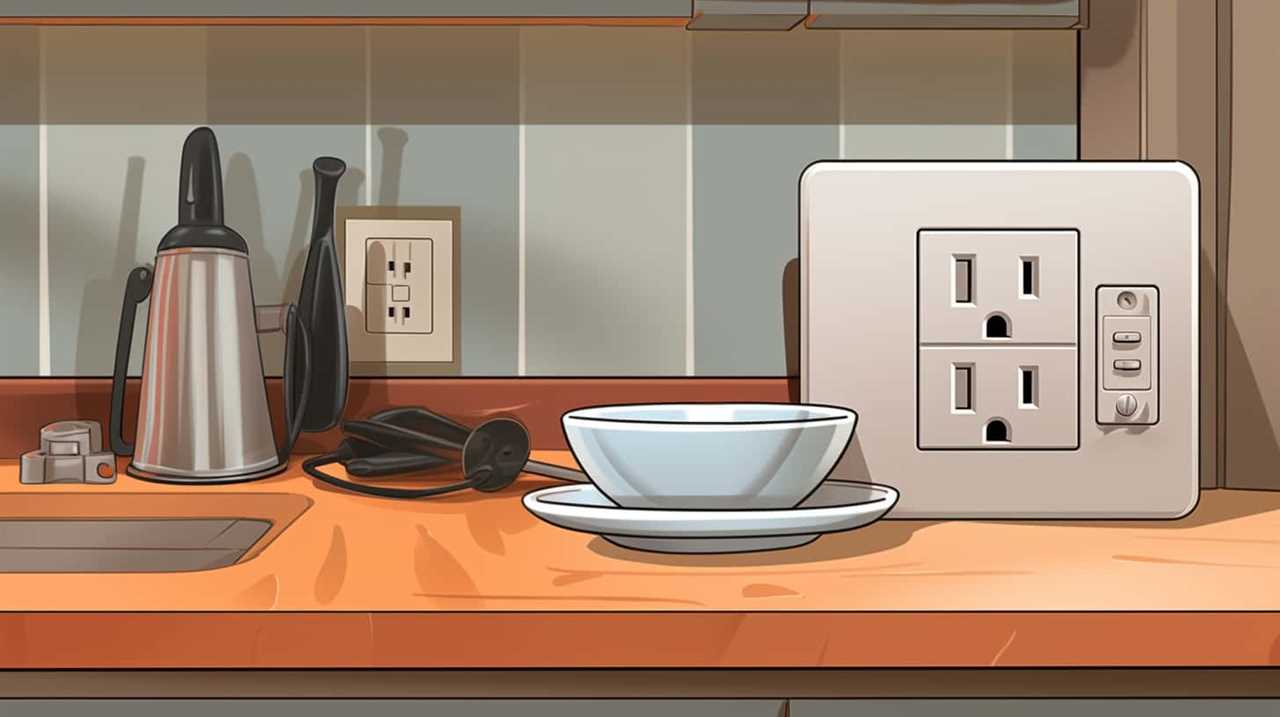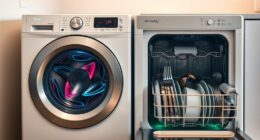Solid-state cooling technologies like thermoacoustic and magnetocaloric systems are advancing rapidly, offering eco-friendly and energy-efficient solutions. Thermoacoustic devices use sound waves in inert gases to transfer heat quietly, while magnetocaloric systems rely on magnetic materials that heat and cool efficiently near room temperature. These innovations aim to replace traditional refrigerants and reduce environmental impact. To discover how these technologies are evolving and what opportunities they hold, keep exploring.
Key Takeaways
- Thermoacoustic cooling uses sound waves in inert gases to produce eco-friendly, silent refrigeration with ongoing efficiency improvements.
- Magnetocaloric systems benefit from new materials like LCMO pellets and reduced reliance on rare earth elements, enhancing room-temperature performance.
- Both technologies aim to replace traditional refrigerants, offering sustainable, low-maintenance, and scalable solid-state cooling solutions.
- Challenges include scaling production, improving efficiency, managing material costs, and integrating systems into commercial applications.
- Emerging trends focus on integrating smart controls, developing low-GWP refrigerants, and advancing materials for broader industrial and consumer use.
Market Dynamics and Growth Outlook for Solid-State Cooling
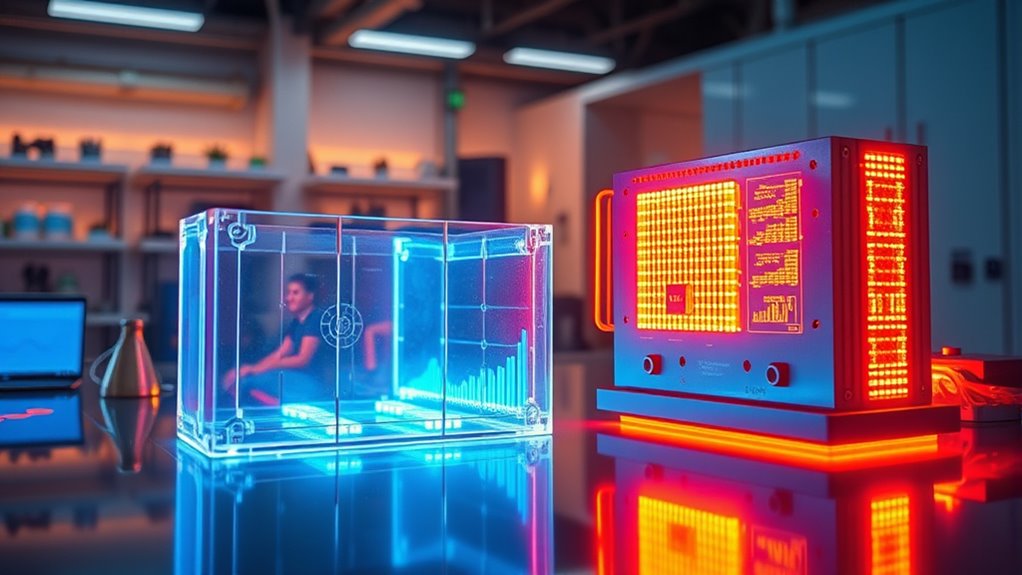
The solid-state cooling market is experiencing rapid growth driven by increasing demand for energy-efficient and environmentally friendly cooling solutions. In 2023–2024, the market size ranges from USD 788 million to USD 1.14 billion, with projections showing a compound annual growth rate (CAGR) between 6.2% and 14.8%, reaching over USD 3 billion by 2032. You’ll see growth fueled by the need for eco-friendly refrigeration that avoids harmful refrigerants, along with rising adoption in electronics, healthcare, automotive, and telecom sectors. Regional markets like the U.S. are expected to hit around USD 455 million by 2032, thanks to defense and medical demands. The trend toward compact, low-maintenance, and silent cooling solutions drives this expansion, presenting significant opportunities for innovation and market penetration. Additionally, advancements in solid-state cooling technologies such as thermoacoustic and magnetocaloric systems are expected to further accelerate industry growth. As AI in Business continues to advance, integration of these intelligent systems could optimize cooling performance and energy efficiency even further.
Principles and Applications of Thermoacoustic Cooling Technology

Thermoacoustic cooling harnesses sound waves traveling within a resonator filled with inert gases like helium or argon to produce a cooling effect. These acoustic waves cause periodic compression and expansion of the gas, creating temperature oscillations along a porous stack. As gas parcels heat during compression and cool during expansion, heat is transferred from the cold end to the hot end, generating a temperature differential. The system typically includes a resonator tube, an acoustic driver such as a loudspeaker, a porous stack, and heat exchangers to remove waste heat. The pressure oscillations generated within the resonator are responsible for the temperature fluctuations that drive the cooling process. There are two main device types: standing-wave and traveling-wave systems, with standing-wave designs mainly used in experiments. This technology offers a reliable, low-maintenance alternative for solid-state cooling applications. Additionally, ongoing research into energy efficiency aims to enhance the performance and feasibility of thermoacoustic systems for broader industrial use.
Furthermore, advances in material science contribute to improved durability and performance of thermoacoustic components, making the technology more viable for commercial applications.
Advances and Challenges in Magnetocaloric Cooling Systems
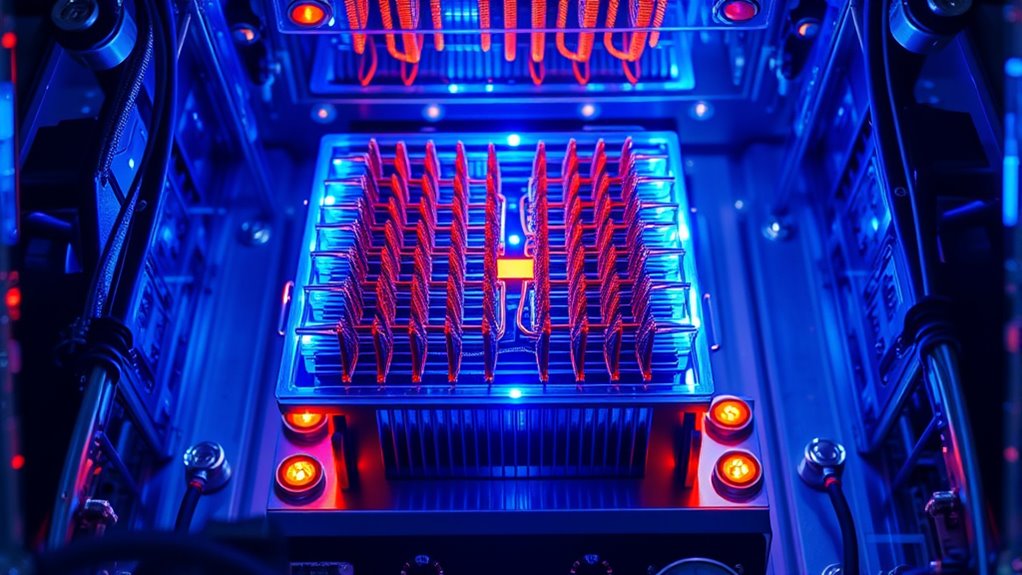
You need to understand that improving magnetocaloric materials’ efficiency is essential for making these systems practical. Scalability and cost barriers hinder widespread adoption, despite recent technological advances. Overcoming these challenges requires focusing on material development and manufacturing processes to enable affordable, large-scale cooling solutions. Additionally, integrating automation technologies can help optimize production and reduce costs in the manufacturing process. Implementing cost‑effective manufacturing methods is crucial for advancing commercial viability and broadening application opportunities.
Material Efficiency Improvements
Advances in magnetocaloric material efficiency have considerably boosted the potential of solid-state cooling systems. You can now benefit from materials like lanthanum calcium manganese oxide (LCMO) pellets, which improve cooling efficiency by over 30% compared to traditional gas compression systems. Operating near room temperature, LCMO uses lower-cost materials and disperses heat more effectively. Recent processing optimizations have achieved over a 20% performance increase in magnetocaloric compounds. Gadolinium-packed beds in active magnetic regenerators (AMR) now match vapor-compression heat pump performance, while newer alloys like manganese-iron-phosphorus-arsenic and lanthanum-iron-silicon avoid rare earth reliance without sacrificing efficiency. These improvements enhance energy performance and reduce costs, though challenges remain in scaling production, managing complex heat treatments, and maintaining stable magnetic properties for consistent system operation.
Scalability and Cost Barriers
Scaling magnetocaloric cooling systems from laboratory prototypes to commercial products faces significant hurdles due to material scarcity, supply chain constraints, and high costs. Rare earth elements like gadolinium and lanthanum-iron alloys are limited, driving up expenses and complicating supply. To improve affordability, efforts focus on reducing permanent magnet use, exploring alternative materials, and developing composites for broader temperature ranges. System complexity and integration—such as heat exchangers and control systems—further challenge scalability. Manufacturing complexities, including precise magnetic control and material handling, hinder mass production. The table below summarizes key factors:
| Factor | Challenge | Solution Focus |
|---|---|---|
| Material Availability | Scarcity of rare earths | AI-driven material discovery |
| System Complexity | Integration and control issues | Simplified design approaches |
| Cost Drivers | High material and manufacturing costs | Reducing magnet and steel use |
Additionally, addressing material availability through innovative synthesis methods can play a crucial role in overcoming supply limitations, especially by developing new material alternatives that mitigate reliance on scarce resources.
Key Benefits of Solid-State Cooling Solutions

Solid-state cooling solutions operate quietly and require minimal maintenance, thanks to their lack of moving parts. They also use eco-friendly technologies that eliminate harmful refrigerants and reduce environmental impact. These innovative cooling methods are also highly scalable, making them suitable for a wide range of applications from small electronics to large industrial systems dynamic cooling processes. Additionally, these systems often incorporate energy efficiency features that contribute to lower operational costs and reduced energy consumption. These benefits make them an attractive choice for applications demanding reliable, sustainable, and low-noise cooling.
Silent, Maintenance-Free Operation
Silent, maintenance-free operation is one of the most significant advantages of solid-state cooling solutions. Without moving parts or refrigerants, these systems produce *no mechanical vibrations*, making them nearly silent—ideal for noise-sensitive environments like offices or bedrooms. They also eliminate sources of fan or motor noise found in traditional systems. This technology aligns with the increasing demand for energy-efficient solutions in modern climate control systems. This quiet performance benefits applications in consumer electronics, medical storage, and computing devices where silence is critical. Additionally, the lack of mechanical components means less wear and tear, reducing breakdowns and maintenance needs. You’ll enjoy lower long-term costs, increased reliability, and less downtime. Key benefits include:
- No moving parts or refrigerants
- Near-silent operation
- Reduced mechanical wear
- Lower maintenance and repair costs
Eco-Friendly Cooling Technology
Eco-friendly cooling technologies are transforming how we approach temperature regulation by substantially reducing environmental impact. Solid-state cooling systems are more energy-efficient than traditional vapor compression units, cutting energy use and lowering greenhouse gas emissions, especially where electricity relies on fossil fuels. Elastocaloric devices can deliver significant energy savings without releasing harmful chemicals, making them a sustainable choice. Many operate without fluid refrigerants, eliminating the risks of leaks and the release of high-global-warming-potential substances like HFCs. While some materials used in these devices are rare and require careful sourcing, ongoing innovations aim to improve recyclability and reduce ecological footprints. The development of recyclable materials in solid-state cooling components further enhances their environmental benefits. Although initially more costly, advancements and economies of scale will make solid-state solutions more accessible, helping to meet global climate commitments and promote greener, safer cooling alternatives.
Technological Barriers and Opportunities for Commercial Adoption
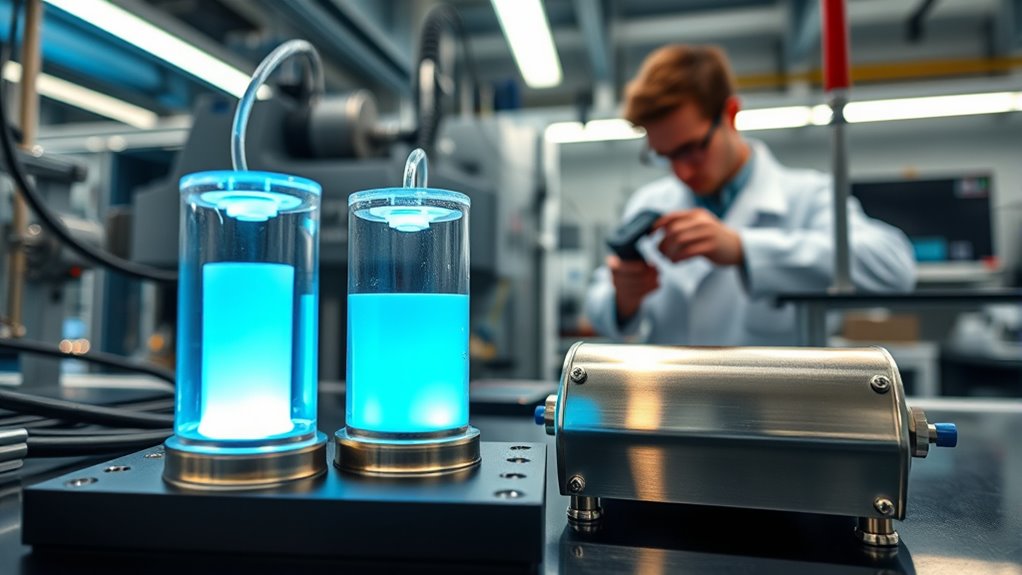
Despite its promising environmental benefits, commercial adoption of thermoacoustic cooling faces significant technological barriers. Efficiency and performance lag behind traditional systems, requiring improvements in heat transfer, stack design, and power density. Miniaturization remains tough, as maintaining effective cooling at small scales is challenging. Managing unwanted vibration and noise is essential for practical use. You also face system design hurdles, like sealing and integrating with existing infrastructure, which impact durability and functionality. The absence of industry standards and limited long-term reliability data cause hesitation among adopters. Additionally, high initial costs and limited technical expertise slow growth. However, opportunities exist in leveraging eco-friendly gases, waste heat, and renewable sources, potentially reducing environmental impact and operational costs, paving the way for future adoption. Vetted – The Pinball Spot. For example, the development of efficiency improvements can significantly enhance system viability and competitiveness.
Regulatory Trends and Innovation Drivers Shaping the Industry

Regulatory trends are considerably shaping the solid-state cooling industry by encouraging the adoption of environmentally friendly technologies. EU regulations are phasing out high-GWP refrigerants, making solid-state solutions more attractive. Stricter environmental standards push industries to seek eco-friendly alternatives to traditional systems, reducing emissions and environmental impact. Energy efficiency standards and incentives further support the adoption of compact, high-performance solid-state cooling devices. International cooperation on refrigerant emission reductions also promotes these technologies globally. Market incentives in countries with strong efficiency policies create favorable conditions for startups and established companies alike. Innovation drivers, like advancements in thermoelectric materials and elastocaloric cooling, boost system efficiency and diversify applications. These regulatory and innovation trends collectively accelerate the shift toward sustainable, vibration-free, and maintenance-free cooling solutions. Additionally, the integration of AI security technologies into monitoring systems enhances the reliability and safety of new cooling solutions, ensuring compliance and optimal performance.
Future Perspectives and Emerging Trends in Eco-Friendly Cooling
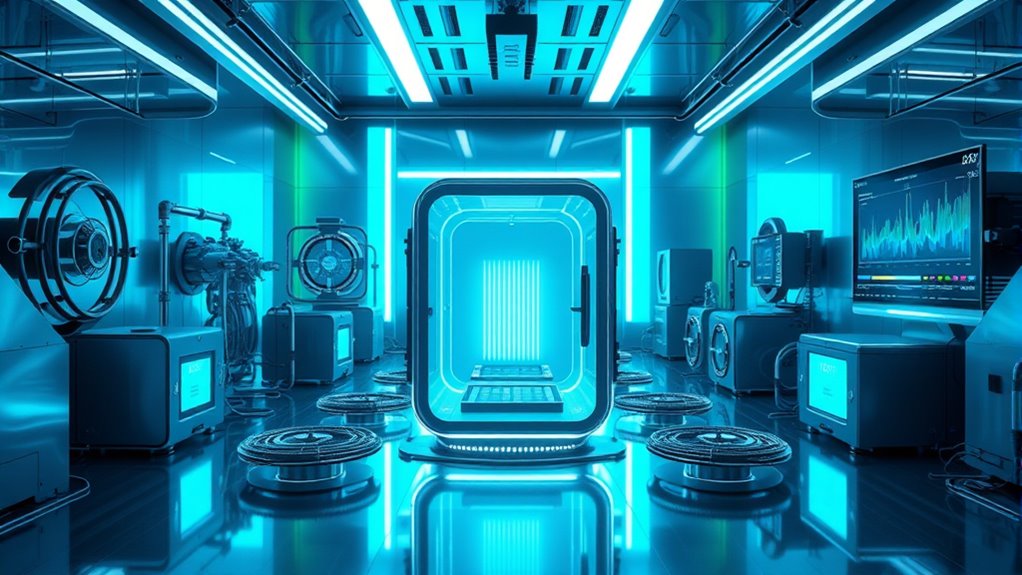
Advances in solid-state cooling technologies are transforming how industries approach sustainable thermal management. You’ll see a shift toward eco-friendly methods like elastocaloric cooling, which uses shape memory alloys to eliminate harmful refrigerants. Thermoacoustic cooling leverages sound waves to move heat without traditional refrigerants, reducing environmental impact. These technologies consume less energy than vapor-compression systems, helping lower greenhouse emissions. Research collaborations are accelerating practical applications in HVAC&R, blending materials science with environmental engineering. Key trends include:
- Adoption of elastocaloric and thermoacoustic systems for greener cooling.
- Integration of smart, digital controls for precise, on-demand operation.
- Progression to low-GWP refrigerants like R-454B and R-32.
- Enhanced indoor air quality through advanced filtration and ventilation.
- Emerging AI-driven solutions are increasingly optimizing cooling performance and predictive maintenance, further advancing sustainable practices. Additionally, ongoing research into solid-state materials promises further improvements in efficiency and durability for future cooling systems.
Frequently Asked Questions
How Do Thermoacoustic and Magnetocaloric Technologies Compare in Efficiency?
You’ll find that thermoacoustic and magnetocaloric technologies have different efficiencies. Thermoacoustic systems can be quite efficient, especially when optimized for specific applications, but typically lag behind vapor compression in overall efficiency. Magnetocaloric systems show promise with near-Carnot efficiencies, but current prototypes are bulkier and require significant energy for magnetic fields. As a result, thermoacoustic devices often consume less energy, while magnetocaloric systems excel in thermodynamic performance potential.
What Are the Main Cost Factors Influencing Solid-State Cooling Adoption?
The main cost factors influencing solid-state cooling adoption include high initial system prices, manufacturing expenses, and the need for ongoing R&D to improve efficiency and reduce size. You’ll find that economies of scale, partnerships with OEMs, and innovations in materials can lower costs over time. However, current bulky prototypes and high upfront investments pose barriers, especially in price-sensitive markets. Streamlining design and expanding production will be key to wider adoption.
Are There Existing Commercial Products Utilizing Thermoacoustic or Magnetocaloric Cooling?
You’ll find some commercial thermoacoustic cooling products like THEAC-25 on rooftops and BlueHeart’s heat pumps for residential use, though they mainly serve niche markets. Magnetocaloric cooling products are still in development, with prototypes but no widespread commercial offerings yet. While thermoacoustic systems are closer to market readiness, magnetocaloric options face hurdles before becoming mainstream, mainly due to cost and efficiency challenges.
How Long Is the Expected Lifespan of Solid-State Cooling Devices?
You’re looking at a future where solid-state cooling devices can run like a dependable marathon runner, lasting around 200,000 hours. With no moving parts to wear out, they’re built for endurance, often surpassing 100,000 hours between failures. Think of them as the steady, silent guardians of temperature control. Their durability depends on quality materials, smart design, and environmental factors, making them reliable allies in critical applications for years to come.
What Are the Primary Safety Considerations for These New Cooling Systems?
You should prioritize safety considerations like ensuring high-quality seals to prevent leaks of high-pressure gases, especially helium, which can penetrate common materials. Maintain proper system pressure and temperature controls to avoid mechanical failures or thermal stresses. Regularly inspect components for integrity, control thermoacoustic oscillations to prevent vibrations, and use inert, non-toxic gases to minimize health and environmental risks. Proper design and monitoring help keep your cooling system safe and reliable.
Conclusion
As you explore solid-state cooling, remember it’s like a gust of fresh air in a smog-filled city—bringing cleaner, more efficient solutions. With ongoing innovations in thermoacoustic and magnetocaloric technologies, you’re at the forefront of an industry poised to transform how we cool our world. Embrace these advancements, because they hold the power to make a difference, just as a single spark ignites a brighter, greener future.





